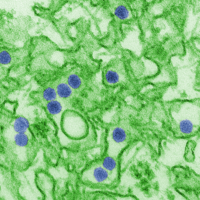
Photo from wikipedia
BACKGROUND Early child development is a critical stage of life that influences social, educational, and health outcomes worldwide. A few years after Zika epidemic, families of children born with congenital… Click to show full abstract
BACKGROUND Early child development is a critical stage of life that influences social, educational, and health outcomes worldwide. A few years after Zika epidemic, families of children born with congenital Zika syndrome (CZS) continue to face uncertainties when it comes to the development of their children. The present study sought to analyze the developmental trajectories of a subset of children born with CZS in the first 24 months of life. METHODS Thirty-five children with CZS were assessed with the Bayley-III Scales at 12 and 24 months of age from November 2016 to December 2018 in a rehabilitation center in Brazil. Inclusion criteria included children with established diagnosis of CZS. Exclusion criteria included the presence of arthrogryposis, prematurity, irregular follow-up, clinical complications, or other causes of microcephaly. Children born with CZS who evolved with cerebral palsy (CP) were classified according to the Gross Motor Function Classification System (GMFCS) at two years of age. RESULTS At 12 months of age mean composite scores on the Bayley cognitive, communication and motor scores were 57.71 (SD 7.11), 57.94 (SD 14.34) and 49.26 (7.20), respectively. At 24 months of age composite scores were 57.43 (SD 7.11), 53.60 (SD 12.29) and 48.83 (7.76). In addition, 31 (88.57%) out of 34 children diagnosed with CP were classified as GMFCS levels IV and V. CONCLUSION Zika virus congenital infection is a risk factor for functional impairments across all developmental domains having a direct and substantial negative impact in early child development.
Journal Title: Child: care, health and development
Year Published: 2022
Link to full text (if available)
Share on Social Media: Sign Up to like & get
recommendations!